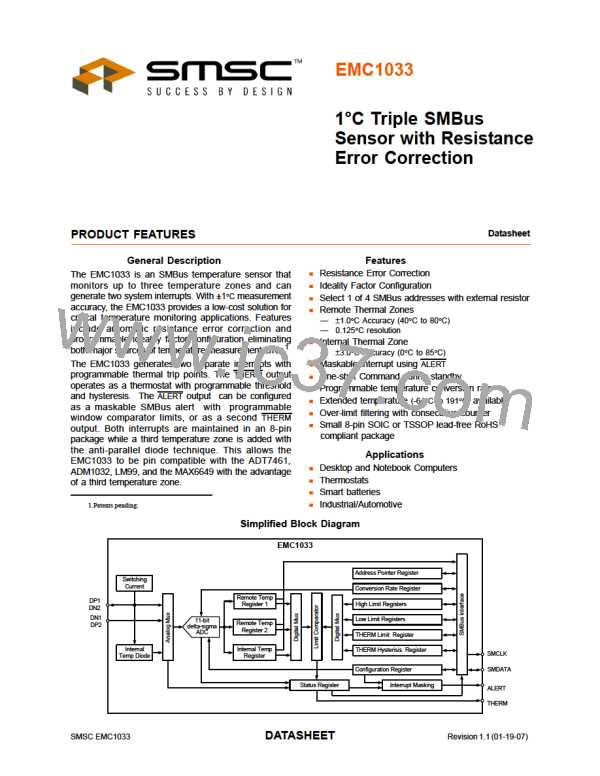1°C Triple SMBus Sensor with Resistance Error Correction
Datasheet
3.4
Receive Byte
The Receive Byte protocol is used to read data from a register when the internal register address
pointer is known to be at the right location (e.g. set via Send Byte). This can be used for consecutive
reads of the same register as shown below:
Table 3.4 SMBus Receive Byte Protocol
FIELD:
Bits:
START
SLAVE ADDR
RD
ACK
REG. DATA
NACK
STOP
1
7
1
1
8
1
1
3.5
Alert Response Address
The ALERT/THERM2 output can be used as an SMBALERT# as described in Section 4.5 on page 12.
The Alert Response Address is polled by the Host whenever it detects an SMBALERT#, i.e. when the
ALERT/THERM2 pin is asserted. The EMC1033 will acknowledge the Alert Response Address and
respond with its device address as shown below.
Table 3.5 Modified SMBus Receive Byte Protocol Response to ARA
ALERT
RESPONSE
ADDRESS
EMC1033 SLAVE
ADDRESS
FIELD:
Bits:
START
RD
ACK
NACK
STOP
1
7
1
1
8
1
1
3.6
SMBus Addresses
The EMC1033 may be configured to one of four 7-bit slave addresses that are enabled based on the
pull-up resistor on the ADDR/THERM pin. The value of this pull up resistor determines the slave address
per Table 1.2 on page 3. Attempting to communicate with the EMC1033 SMBus interface with an
invalid slave address or invalid protocol results in no response from the device and does not affect its
register contents. The EMC1033 supports stretching of the SMCLK signal by other devices on the
SMBus but will not perform this operation itself. The EMC1033 has an SMBus timeout feature. Bit 7
of the Consecutive Alert register enables this function when set to 1 (the default setting is 0). When
this feature is enabled, the SMBus will timeout after approximately 25ms of inactivity.
Revision 1.1 (01-19-07)
8
SMSC EMC1033
DATASHEET

 SMSC [ SMSC CORPORATION ]
SMSC [ SMSC CORPORATION ]